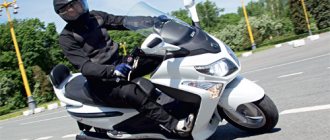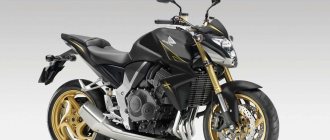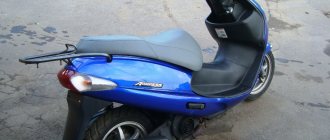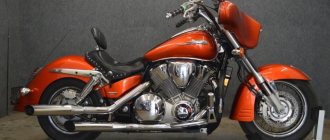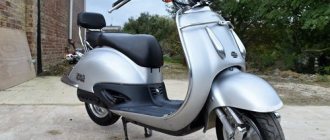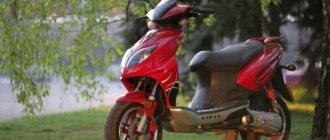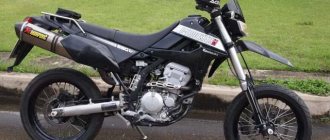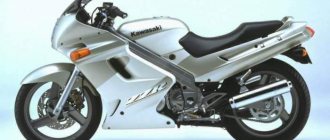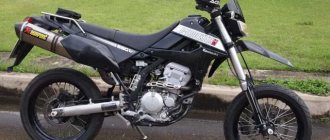Having one hundred and fifty thousand in hand, I chose the first chopper, eventually bought a Kawasaki Vulcan 400, ordered it from Vladivostok through a motorcycle dealership. They brought it and inspected it, nothing was wrong, not without mistakes, of course, then there’s age and price. The first impression of the first motorcycle, of course, was delight, where would it be without that, and then on the whole I was satisfied, but not with everything.
As a motorcycle for every day, the VN400 is generally excellent, the dimensions are average, the weight is average, and it’s very comfortable to ride around the city. The engine is rather weak, it can’t drive, after 70-80 mph it accelerates reluctantly, but it easily reaches its 130 honest mark. Racing is not his thing; Vulkan doesn’t race, but moves slowly. It pulls well, but only at the very bottom, as soon as the engine spins up, the traction disappears. The gearbox clicks normally; however, it is not always possible to catch neutral the first time, but I think this is due to wear and tear on the parts; the motorcycle is old.
The fit is comfortable, the seats are good, nothing gets numb after a couple of hours without stopping. Consumption is four liters outside the city, about five in the city. It doesn’t burn oil, at least for me, although I haven’t heard of Vulcans 400 suffering from such an ailment. In general, this motorcycle doesn’t seem to have any birth defects, or I was just lucky. So, in principle, everything is fine with it, except that the traction is not enough and the brakes are so-so. The rear drum brake is of no use at all; engine braking is even more effective than it is, although the front brake is better.
With long legs it’s still not very comfortable to sit, it’s a bit cramped. It would be possible to build stems, but it costs money, and since I initially bought a motorcycle purely to learn how to ride and then buy something fresher and more powerful, I didn’t bother. The passenger footrests are also inconveniently located, too high. Although passengers generally need to be seated with caution, the rear shock absorbers are weak, and with a total weight of the driver and passenger of 130-140 kg, the feed sags so that the wheel begins to rub against the fender. They say that you can make a spacer for the shock absorber, it will be stiffer, but the problem will go away. I haven't tried it.
So overall it’s an ordinary chopper, as I expected, there aren’t enough stars in the sky. The size is quite large, there is a lot of beautiful chrome, if you find a version that is not particularly worn out. Just right for a beginner. I skated the season, gained experience and sold it.
Similar articles:
- Yamaha XJR 1200 owner review
- Yamaha XJR 400 owner review
- Honda CB 250 F Hornet owner review
- Honda VFR 400 owner review
- Yamaha XVS 650 Drag Star owner review
- Kawasaki Ninja 250 R owner review
LiveJournal
Review of the Kawasaki EN 400 Vulcan motorcycle
The dynamics are crazy, the bike is responsive, so I had to learn to release the clutch correctly. The first days it shamefully stalled when trying to move away from a traffic light. But keep in mind that this was my first time on a motorcycle. (Rides in Uncle Vasya's Minsk at the dacha don't count) But the combination of a chopper chassis with a high-speed sports engine provides amazing opportunities - should you take a quiet ride while admiring the surrounding nature?
Please. We need to show the shabby little bastard that his place is near the bucket? Easily.
The gears are long, the engine pulls equally well both at low and high speeds, so there is no need to frantically catch the moment when it’s time to change gear. When it works out, then it will switch.
The rear shock absorbers are reliable - they were used under the previous owner, they lasted a season under me (6 thousand) and, as they said at Kamikaze (I recommend them there. Competent, nice guys), at least the season is still going away. I won’t say anything about the fork yet, since, as it turned out, I rode a dead one all season. =)
The seat is very comfortable, so much so that it is already relaxing. I’m thinking of installing a removable backrest for myself (not for the passenger - he already has one) but for myself. By the way, about the passenger. The bike is of course solo. That is, there is a back seat, the passenger sits down, the bike pulls, but (!) it starts to eat quite a bit of fuel. If with me alone, he takes about 5-6 per 100, then with a passenger at least a liter more. In general, as I understand it, the passenger seat is there solely to “take the girl from the bar to the bed.” And it is right ! Women come and go, but the bike lasts a long time.
In general, as soon as I got used to the clutch, I stopped getting off it.
Maybe for the night. The biggest disadvantage, in my opinion, is the lack of a glove compartment. Completely. A tiny little pencil case for some instrument under the seat, I think, is not worth mentioning. So it's time to buy panniers. Gears shift well, and there are no problems with neutral either. Well, it almost doesn't happen.
3 10 times one neutral is not caught immediately. I haven’t figured out the patterns yet.
The same Kamikazovites said that everything was fine with the box, so it’s not a bug, it’s a feature. A ! Main ! I almost forgot. He doesn't have a chain. And not the cardan. He has a BELT!
Moreover, the manufacturers swear that the belt is Kevlar, God knows what, and the warranty mileage of the belt is 800 thousand. I don’t know - I don’t know.. But during the season I was never at all interested in what my engine was transmitting to the rear wheel. That is, no maintenance is required for this node. At all.
It takes turns very easily, holds the turn confidently, that is, although I was afraid every time, there was not a single skid, loss of road or other nasty things.
I put it down, went through the turn, picked it up. (Pah-pah-pah)
The front brake grabs you to death (I almost tumbled over the steering wheel a couple of times), so after a while I learned to pretend to use my hand to imitate ABS =)
The rear brake applies softly and gradually, but if you press harder, it also holds firmly. On a good road, even if the wheel is blocked, it slides straight, but on crap (gravel, cobblestones, dead asphalt) it skids. For some reason it always goes to the right. For the first month I only used the rear brake.
So, the downsides are the lack of a glove compartment, and a tight, sensitive clutch (swing your left hand!)
And the rest are advantages.
A few impressions... The motorcycle is a beast, more of a dragster. I didn’t realize that a chopper could be so sporty, but now if you take a bike, then only a dragster. About the service. Consumables don’t bite, but you need to monitor the condition of the timing chain and tensioner, adjust the valves every 10-12 thousand km, due to the design, and to adjust, you need to drain the cooling system - a small unpleasant detail. The drive is a belt, it runs for a long time, it can easily withstand 50 thousand, but replacement will cost a tidy sum: about 30,000 rubles.
About my personal repair experience: a bike was stolen a couple of years ago and hit a tree. Tank, fork, tidy (rare, like on the LTD 454, with a tachometer), headlight mounts, turn signals (everything), steering wheel in half, the radiator began to sweat, something like this. The steering wheel, from disassembly for 1500 rubles, is straight - it’s actually become more convenient to toss and turn around the city. It hit the radiator because... The procedure “pour 100 grams in 2 weeks” did not bring any particular discomfort. I made the fasteners natively, using (almost) straight hands. The tank was straightened and painted by friends (0 rubles on the Master Card). Turn signals China “chopper type, chrome type” about 1500 per set. The tachometer had to be amputated (it was really inconvenient without it, it wasn’t enough for my eyes). Master Uncle Vova straightened the feathers, everything was perfectly straight (a bubble of 0.5 cognac). A year ago I came across a donor for 20,000, the same bike, ENTIRELY spray painted with black mat (collective farm Herods), dockless. I immediately went to pick it up 300 km away on a Gazelle (3000 to a friend). The bike turned out to be running, the engine was alive. I immediately amputated the fork, the tidy (working!), and the radiator. Now I don't bother at all. A problem happened on the original engine: a washer (no idea where it came from) got between the timing chain and the crankshaft sprocket, the result was removal and disassembly of the engine. Diagnosis - the tensioner and chain are ready. I found a solution right away; in one day I swapped the engines (fortunately, the engine is now a spare part). That's how it happens.
Hodovochka. The volcano is really low. Yes, yes, all the police must be passed carefully, at the speed of a drunken turtle, otherwise the connection of the mufflers from below begins to suffer. The suspension is very soft, but no penetrations were noticed. At speeds the motorcycle feels very confident; at a speed of 130 km/h the truck practically does not notice. The fork is pneumatic-hydraulic, this allows you to more accurately prepare the bike for a specific trip.
The gearbox is 6-speed, which is quite enough. The engine is slightly derated compared to the KLE series, but in sixth gear at a speed of 60 km/h it begins to accelerate quite confidently. You often come across cries for help from the owners, saying they have trouble starting in the cold. This is fine! I almost started to remove my head to check the valves, but I thought better of it in time. The motorcycle in winter (it was necessary, it was necessary) started on only one cylinder, and as it warmed up, sometimes the second one began to turn on. After warming up with a heat gun, the motor worked like clockwork. Overall, an excellent bike for the money, with a moderate appetite, reliable, very nimble. Moreover, with a pusher, the dynamics almost do not change, only the consumption increases slightly.
Go to the Kawasaki EN 400 Vulcan
Prices
A Kawasaki ZZR 1100 motorcycle in good technical condition today can be found for around $4,000. If the previous owner rode only on the roads of distant countries and has never been to Russia and the CIS, the price may be higher. Offers with prices below $3,000 should be wary - such motorcycles in most cases have faults.
In our area, as a rule, there are versions produced for Europe and Asia, the power of which does not exceed a hundred hp. With. American 147-horsepower motorcycles are a rarity.
Motor and its features
The Kawasaki ZZR 1100 engine has impressive performance. Representatives of the full-power series, which mostly settled on the US market, impress with a power of 147 horses. Models released for the markets of Europe and Japan have slightly smaller, but still impressive characteristics, delivering power in the range of hundreds of horsepower.
The motor has not only considerable power, but also large dimensions. 4 cylinders are installed in a row, their total volume reaches 1052 cm3.
Modifications
The debut of the Kawasaki ZZR 1100 motorcycle took place in 1990. The model released for the American market is known to the world under the name ZX11 Ninja. 1992 was marked by a number of modernization measures: the base was increased (by 15 cm), the characteristics of inertial charging systems were improved. Power reached 147 hp. With. For the domestic market of Japan and some European countries, a light version with a power of up to a hundred horses was first produced.
Pendants
Kawasaki ZZR series motorcycles manufactured before 1993 do not have suspension adjustment. And later releases are equipped with it, and on them you can adjust the spring preload and rebound damping at your discretion. Despite the modernization, the ZZR suspension leaves much to be desired. The fork stays are thin, which significantly worsens handling. At the same time, they are so reliable that before a run of 30,000 km you may never even think about them. After crossing this line, there usually comes a time when the seals need to be replaced. Keep an eye on the rear shock absorber, which may suddenly fail due to rod corrosion.
Problems
The Kawasaki ZZR 1100 motorcycle, reviews of which indicate a number of chronic ailments, is not so easy to maintain. First of all, this concerns the operation of the checkpoint. It only works smoothly when the motorcycle is young. As soon as he runs at least 20-30 thousand, problems make themselves felt. When switching on, the second and third gears slip. Blaming this on a lack of neatness and the aggressive style of the former owner will not work, because the problem is widespread. At the same time, competitors of the same years of manufacture and with similar characteristics do not have such difficulties.
Often, immediately after purchase, there is a need to rebuild carburetors. Reviews indicate that this is not so easy to do on the Kawasaki ZZR 1100. The fact is that the carburetor block is very difficult to remove. Access to it is difficult; most likely, you will have to contact the service. The tidy also raises questions. The glass is glare, the numbers are small.
The motor is structurally noisy; only a specialist can isolate harmful noises from the range. But you will have to do this, because due to extraneous sounds you can miss the noise of the generator drive chain caused by a malfunction of its tensioner. The clutch also requires regular checks.
Reviews indicate that the rear subframe on these motorcycles is often damaged. It is welded to the frame and may crack. This can be found if you remove the saddle and look under the rear trim. Be sure to do this before purchasing so as not to inherit this flaw from the previous owner.
Often causes criticism and light. Headlights and turn signals fail and require replacement. This is also one of the “signature diseases” of the series. However, when purchasing goods on the secondary market, you may not encounter this problem. Perhaps the previous owner removed it at one time.
Comfort
The Kawasaki ZZR 1100, whose technical characteristics are conducive to long and fast trips, is stable on the highway and comfortable for long trips. This is evidenced by numerous reviews.
The pilot's position is comfortable; he has to lie down on the motorcycle at speeds close to two hundred. Good wind protection minimizes the influence of oncoming air currents.
The passenger seat is normal, traditional for the sport class. Its dimensions are very modest, but this feature is inherent in most motorcycles in this category.
